Stories
Peplum Panache

A skirt-like addition attached to the waist seam of a jacket, dress or blouse, the peplum emphasises the hips and accentuates the waist. Long or short, flared, fluted, structural or gently curved, its interpretations are many and varied. Whatever the era, it has proved adaptable to the silhouette of the time. The modern peplum harks back to the 1800s when it was fitted to jackets to define tiny corseted Victorian waists.
A peplumed dress in the New Zealand Fashion Museum collection, made by Olga Reed (nee Fletcher) for her wedding in 1937, was possibly inspired by the Mainbocher dress worn by Wallis Simpson when she married the Duke of Windsor the same year. The bias-cut line of the dress was similar, as was the colour blue, but Olga added a peplum with a satin scallop edge and satin belt.
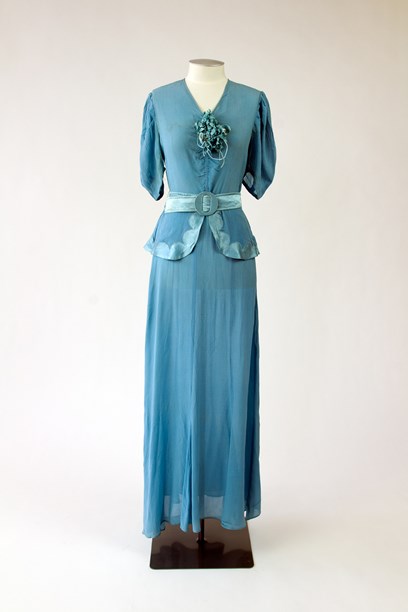
Blue dress made for her wedding in 1937 by Olga Reed. Image from the NZFM collection, CC BY 4.0 International Licence.
Peplums were more popular in the 1940s than they were in the 1930s. Wartime fabric shortages and austerity measures precluded anything too fancy and the addition of a modest peplum made a simply cut garment look less severe. With stars such as Joan Crawford adopting the trend, Hollywood also played its part in popularising the peplum. One peplum suit in particular, worn by Lauren Bacall in her first movie To Have and Have Not in 1944, was much admired and widely copied. Made from a houndstooth check wool fabric, it had square shoulders, big buttons and a pencil skirt.
McCalls dress patterns from the 1940s.
For New Zealand designers like Bruce Papas, Christian Dior’s New Look, introduced in 1947, was a revelation. "After a long period of regimentation," he says, "fashion became feminine again." Like Dior, he used peplums to give the tailored suits for his Staevro Gowns label a more womanly shape, deftly sculpting them to embrace the hips and make the hip-line look longer. Unlike Dior, he didn’t pad his peplums, preferring to let the fabric sit as it would do naturally.
Staevro Gowns tailored suit with New Look peplum, Bruce Papas, early 1950s. Images courtesy of Auckland Museum, © Bruce Papas.
Bruce Papas also enjoyed hip-draping which created a similar effect to the peplum, focusing the eye on the hips and minimising the waist. An example of his draping expertise can be seen in a blue cocktail dress with a gathered half peplum and bow he designed while serving his apprenticeship at Ninette Gowns in the late 1940s.

Cocktail dresses with a half peplum and bow (left) and hip-draping (right). Designed by Bruce Papas for Ninette Gowns, late 1940s. Image courtesy of Auckland Museum © Bruce Papas.
Peplum suits designed for summer tended to be cut on less structured lines. But although there was more ease in the jacket, skirts retained their pencil slimness and the look remained unmistakably ‘dressed’.
For cocktail-wear, the 1950s’ peplum sometimes assumed the proportions of a flared skirt descending to mid-thigh. Worn over a straight skirt in a matching fabric, it bore a passing resemblance to the lampshade silhouette created by the French couturier Paul Poiret in 1912.
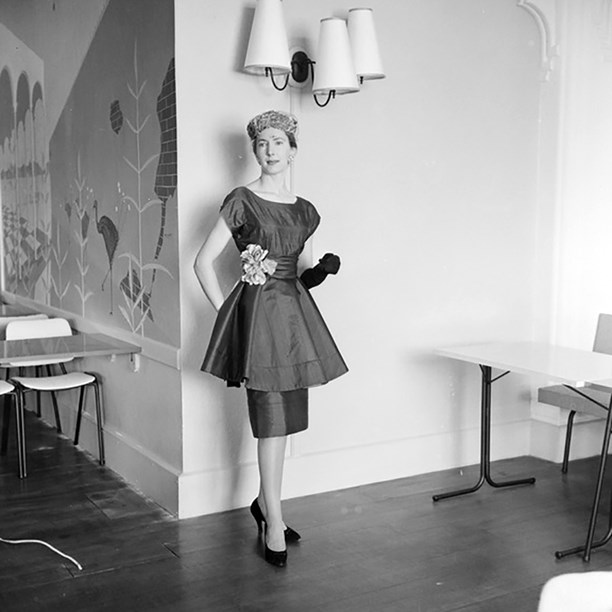
Cocktail dress modelled at a fashion show, James Smith’s, Wellington, 1959. Photo from the Evening Post newspaper, courtesy of Alexander Turnbull Library, Ref: EP/1959/2946-F.
The transition from New Look hauteur to Mods and minis in the 1960s saw a decline in the popularity of the peplum. In the 1970s, it reappeared in a new softer guise, channelling Laura Ashley and The Little House on the Prairie.
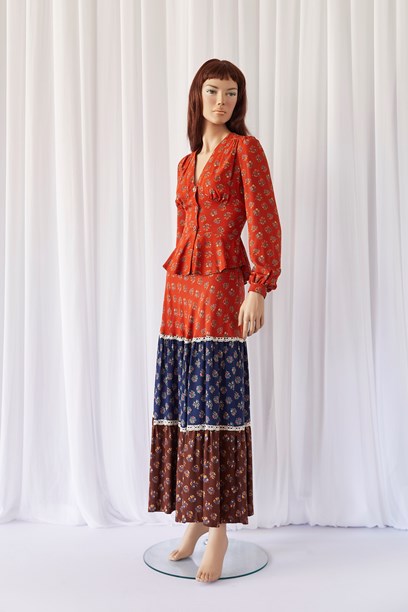
Peplum top and tiered skirt in a sprigged floral print by Jennifer Dean, circa 1975. Photo by Frances Carter for New Zealand Fashion Museum, CC BY 4.0 International Licence.
Shortly after his arrival in New Zealand from England in 1980, Brian Molyneux designed a small collection of peplum pieces for Durham Arts and Crafts in Auckland. Fanciful and full of flounce, they were fashioned in silk, satin, lace and other delicate fabrics. A big fan of the peplum silhouette, he says he loves what it represents. "By creating the illusion of a small waist and rounded hip, it celebrates the curvaceousness of the female form. I did many variations of the peplum in my couture collections over the years and once made a beaded silk peplum jacket for a bride."
Brian Molyneux sketch for Durham Arts and Crafts collection, 1982. Images © Brian Molyneux.
Women who, a decade earlier, would have looked askance at ruffles, revelled in them in the 1980s. The peplum, especially on cocktail and eveningwear, helped to feed the new appetite for luxury and ostentation.
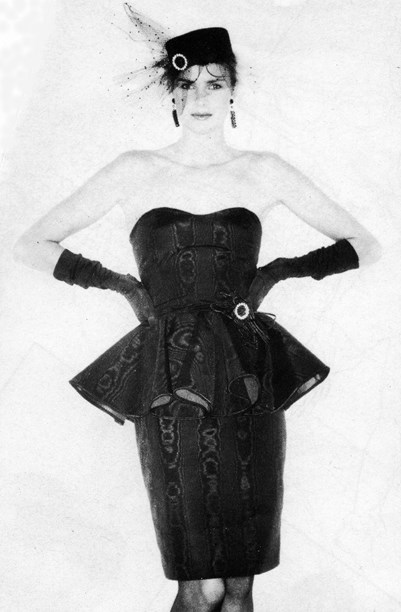
Strapless moire taffeta cocktail dress, Fashion in New Zealand, Autumn/Winter 1983. Modelled by Kirsteen Price, photo by Euan Sarginson.
At the beginning of the 1980s, peplums were relatively restrained but as the decade progressed they dared to be big like everything else. Multi-layered and extravagantly ruffled, they sprouted from the waists of party dresses and power suits alike. In 1988, the boldness extended to colour and print. Roses ran rampant, thanks to French designer Christian Lacroix, and bright colours were all the rage. Among the designers to pick up on this theme was Patrick Steel whose prodigious output of lavish peplum offerings included a double peplum hot pink jacket buttoned over a matching yellow dress abloom with long-stemmed hot pink roses.
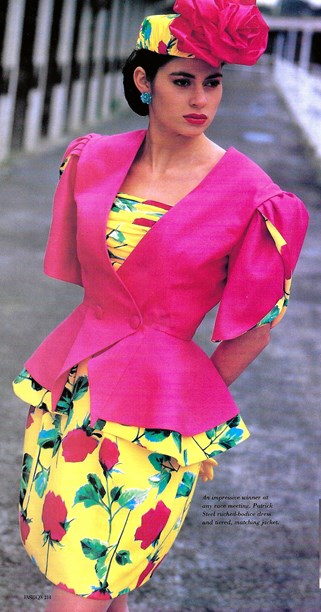
Patrick Steel double peplum jacket and matching ruched bodice dress. Fashion Quarterly, Summer 1988.
Rivalling the theatricality of Patrick Steel’s creations were those of Barbara Lee. Barbara liked pushing the boundaries. There was often an element of wear-if-you dare in her designs and her 1980s’ peplum suits were no exception. Featuring cascading multi-layered peplums or short flouncy peplums fanning out beneath wide belts, they were true statement pieces, requiring insouciance and flair to carry off.
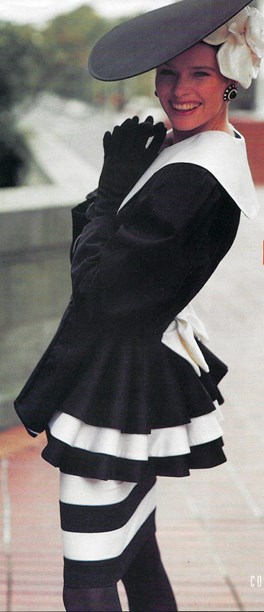
Black and white pure wool suit with a triple-tiered peplum jacket caught at the back with a flat bow. Barbara Lee Couture Collection, Fashion Quarterly, Winter 1988. Hat by Dollie Vardin. Photo by Richard Bailey.
The televised Benson & Hedges Fashion Design Awards were a good indicator of seasonal fashion trends, in both the non-competitive manufacturers’ showcase, Salute to New Zealand Fashion, and in the nominated categories. In 1989, peplums appeared across the board. Dreamgirls presented shapely red suits with fluted peplums from their winter range and a number of entrants who incorporated peplums in their designs were nominated for the Wool and High Fashion Daywear Awards. Liz Mitchell was Highly Commended in the latter category for a cream wool suit with a crossover draped peplum jacket and tulip skirt. A costume designer before launching her eponymous fashion label in 1990, Liz says peplums appeal to her sense of theatre. "They're exaggerated, they add drama. A full peplum kicking out over a narrow skirt can look really dramatic."
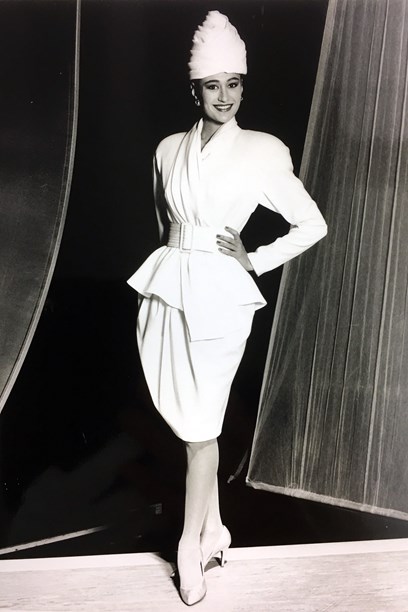
Liz Mitchell cream wool suit, Highly Commended in the High Fashion Daywear category, Benson & Hedges Fashion Design Awards, 1989.
Peplum suits and dresses were traditionally made from wool or silk fabrics - Bruce Papas sourced his silks from Abrahams, the French textile house patronised by the French couture - but from the mid-80s on, they were also cut from leather. The suitability of leather as a high fashion material was made possible by new tanning techniques and the availability of finer, softer, more malleable skins.
White leather peplum suit by Rosaria Hall, 1980s. Modelled by Rosanna Raymond. Image © Rosaria Bresolin Hall.
Depending on designer whim, the peplum continues to crop up from time to time on the catwalk and in the shops. Kate Middleton, Duchess of Cambridge is often photographed wearing peplum suits, tailored designs similar to the red 1940s-style one she wore in Christchurch on her New Zealand visit in 2014.
Whatever the fashion of the day, peplums remain a red carpet favourite. At the 2020 Oscars, Saoirse Ronan (Little Women) walked the walk in a Gucci gown with a peplum whose surrealistic undulations brought to mind the creative collaboration between the designer Elsa Schiaparelli and the artist Salvador Dali in the 1930s. The peplum as fashion fantasy.The peplum as art.
Text by Cecilie Geary. Banner image of sketch by Brian Molyneux for black lace cocktail separates, 1982. Image © Brian Molyneux.
Published March 2020.